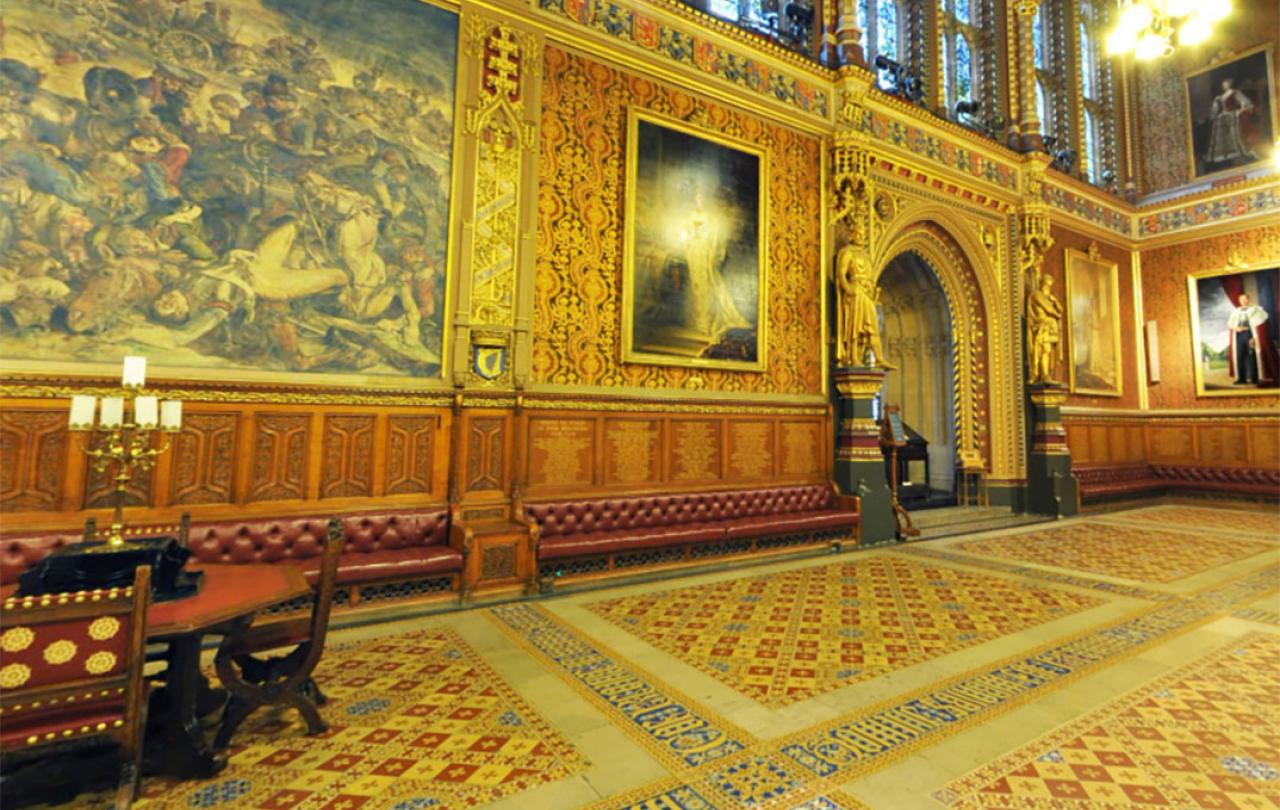
Engraved into the floor tiles of Westminster’s Royal Gallery are the words Cor Reginae in Manu Domini, which is the Latin script from the biblical book of Proverbs. However, there is one salient difference, one which has caught both my attention and imagination. In English, the original Proverb reads,
‘in the Lord’s hand is the king’s heart’
But what is written on the floor of the Royal Gallery is,
‘the Queen’s heart is in the hand of the Lord’
Right there, on the floor of the Palace of Westminster, is a little piece of feminist theology.
In a parliament that was the apogee of Victorian values and sentiment, the political and cultural epicentre of an Age that was (ironically) remembered in reference to a woman but was nevertheless pontificated on laws that treated women as chattels, these tiles were theological dynamite (as opposed to literal dynamite – that was a few centuries earlier).
Female empowerment was present below the feet, if not within the hearts and minds, of the men who oversaw an era of undeniable and near-absolute patriarchy.
Feminism: A little context
Feminism is not an easy concept to define. It isn’t black and white, however much we wish that it were. In truth, it more accurately resembles the entirety of the grey scale. It cannot claim to be singular any more than the female experience is singular. In reality, it is brimming with nuance, complexity, and subjectivity. What’s more, I would confidently wage a bet that you have arrived at this article with an already in-tact pre-conception of the term. None of us approach feminism neutrally, be weary of anyone who claims to do so – it is simply impossible. Therefore, we are not only faced with the endless external nuances of feminism, but we’re also tasked with sifting through our differing internal understandings. Like I say, it’s about as definable as the shade of grey.
Nevertheless, for the sake of being on the same page, allow me a moment to try. A moment to (briefly) unpack what I mean by the term feminism. For that, I will borrow the words of award-winning author Chimamanda Ngozi Adichie, who influentially declared that feminism is the belief in ‘the social, political, and economic equality of the sexes.’
That’s it.
To me, feminism is nothing more, and certainly nothing less than that. Of course, as a self-proclaimed feminist, it’s necessary for me to plunge the dark depths of the subjective nature of such a belief. But it is more important to ensure that I continually come back up to the surface for a deep breath of air, and I consider Chimamanda’s over-arching definition to be that air.
With Chimamanda’s words filling our lungs, let us dive beneath the surface for a moment.
Feminism has, and still does, get worked out in the most tangible of ways: through marches on the streets, protests outside government buildings, petitions, boycotts, legal battles and demands. All of which is advocating for the empowerment of women, the restoring of an equilibrium, and the ensuring of that all-important equality of the sexes.
As well as the macro-examples that adorn the history books and media outlets, we must also acknowledge the micro-battles; the thousands upon thousands of non-news-worthy conversations, changes, and decisions that nudge the individuals and communities involved toward the very same goal of equality. After all, feminism is as personal as it is political. And all of these actions, past and present, whether they be macro or micro in scale, are (often imperfectly) working toward the practical, tangible, measurable flourishing of women and therefore society.
And so, with all of that practical work going on – with the many battles won and the many more that are raging on - why on earth would we need something as abstract, as contemplative, as time-swallowingly-indulgent as feminist theology?
I’m glad you asked.
Feminist theology as an imaginative endeavour
By way of an answer, I’d like to return to those words on the floor of the Palace of Westminster. Victoria was the Queen. She wore the crown, she sat on the throne, she lived in the palace, she presided over the government, she ruled over the country. All the evidence was there; it would have taken a rather large dose of delusion for anyone to have questioned it. And yet, according to the existence of those floor tiles, the tangible evidence wasn’t quite enough.
Queen Victoria’s right to be such was ultimately held by the divine. So much so, that the intangible was made tangible, literally carved into the ground that she (and others) would walk upon. And therein lies the need for feminist theology.
Whether one considers themselves to be Christian or not – or even religious, for that matter – we all have ‘imaginative landscapes’. Not ‘imaginative’ as in fantasy, but rather, ‘imaginative’ as in our landscapes of thought. These are the interior places where we attach meaning to our experiences, and therefore judge the significance of every waking moment. As Francis Spufford so eloquently puts it,
'we are meaning-making creatures. We cannot stop making enchantments.'
This is also the realm in which we wonder about the existence of God, the mysteries of our universe, and the significance of ourselves.
And so, it’s in those places, as well as the practical, that work is being done toward the equality of the sexes. It’s in those places that we must grapple with the inherent value of women. Because, in many ways, those are the truest places. Those are the places where reality is crafted, ordered, and understood. It is in those places where truth is sought, viewpoints are galvanised, and actions are decided upon. Feminist Theologian, Serene Jones, writes it this way,
‘Closely tied to the view of practical transformation is feminist theology's contention that changing society requires both changing laws and practices and challenging the categories and processes we use to think about life and to make sense of our world.’
In short, feminism has work to do in both the seen and the unseen. Feminist theology, therefore, is an imaginative endeavour. Which makes it a profoundly important one.
It is the work of digging into biblical texts with an un-denied bias, a particular mission, a sole question that needs answering. We do so in order to uncover what the maker thinks of the made (the maker being God, the made being women), and from there do all other feminist inclinations flow. We find evidence of the empowerment of women in the divine agenda, so it naturally gets included in ours. We spot profound equality of the sexes present in the original blueprint of a flourishing earth, and so we work in partnership with it. We find validation of female worth, value and power in the pages of the Bible, and then work about writing it into the pages of the history books. And on it goes. We get things straight in our imaginative landscapes, and then we get them straight everywhere else.
Did the fact that Queen Vicotria walked upon those affirming floor tiles eradicate any possibility of sexism or misogyny? I doubt it. But I like to think that it was a profound start-line, a radical piece of feminist theology that we are still running to catch up with.
You may be thinking that this is interesting, albeit utterly irrelevant. Because we now live in a secular society, one where we don’t need any kind of God to legitimate the way we perceive anything – least of all ourselves. This is not the good old Victorian era, after all.
And to such arguments, I may be tempted to direct you toward the work of Nick Spencer or Tom Holland and suggest that we’re not quite as secular in our values as we first appear. Or perhaps I could point you to the discography of Nick Cave, Lauryn Hill, Paul Simon or Stormzy and question whether our craving for something truer than what we can see is a craving we’ve truly progressed beyond? Or even bring to your attention the fact that the Barbie Movie is the highest grossing film of the year (you didn’t really expect me to not mention that film in an article about feminism, did you?), and argue that we’re obsessed with wondering what we’re for, what makes us who we are, what generates our value. It is an itch we cannot stop scratching.
I could point to all those things. But oddly, I don’t feel the need to. Because I think you know, as do I, that our imaginative landscape is there, and it matters. We know it, we engage it, we feel it.
And that’s why feminist theology matters. At least, to me.
Gosh. All those thoughts from a few floor tiles. Maybe I need to get out more.
All insights into the Palace of Westminster are curtesy of Richard Hall; architectural historian and author of The Palace of Westminster: Faith, Art, and Architecture: an illustrated guidebook that uncovers the Christian legacy that underpins the visual culture of the Palace of Westminster.





